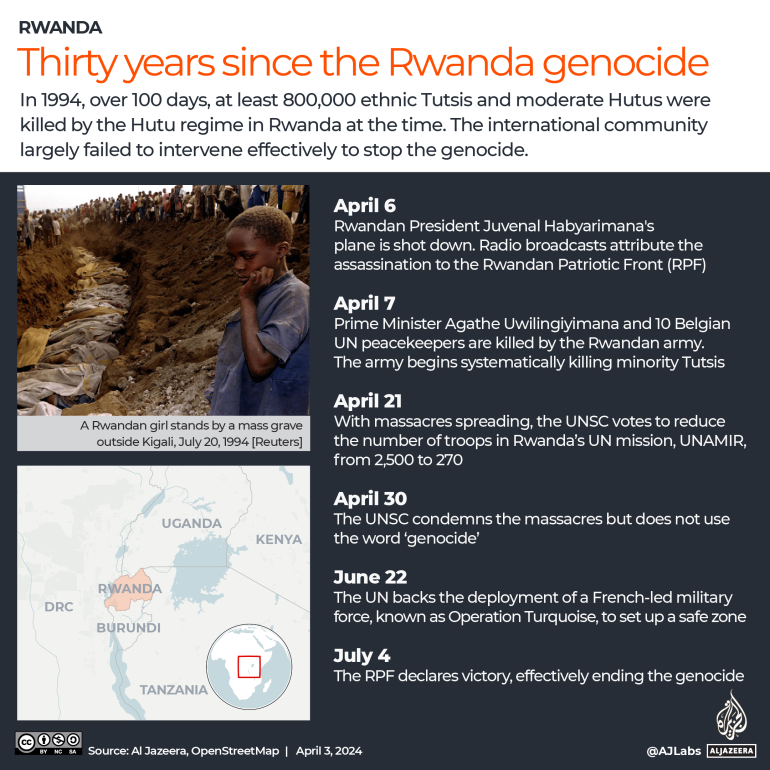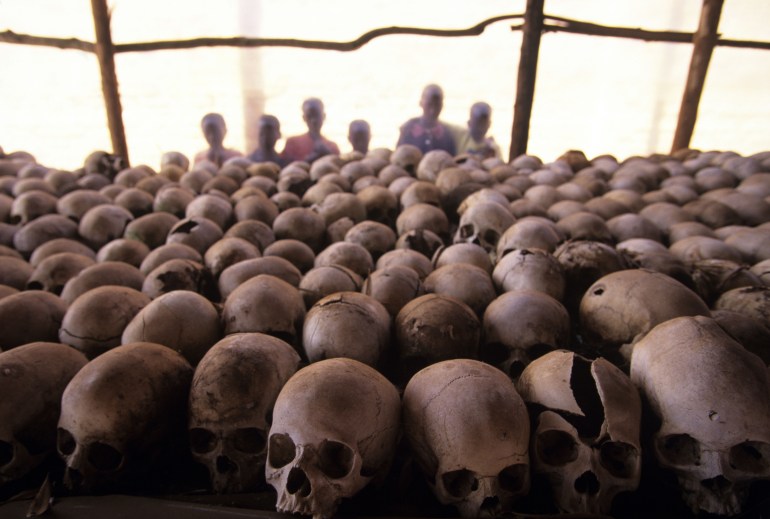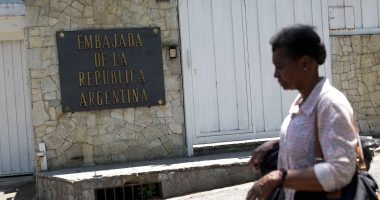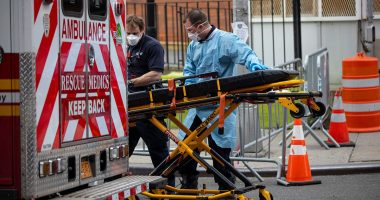It has been three decades since the April 1994 Rwandan genocide when members of the majority Hutu ethnic group killed an estimated 800,000 minority Tutsis, moderate Hutus and members of a third ethnic group, the Twa, in one of the darkest episodes in world history.
A combination of colonial-era favouritism towards the Tutsis that angered other groups, a media landscape that was ripe for spreading hate and the slowness of the international community to respond to the crisis all combined to fuel the genocide.
The killings have continued to reverberate in East Africa, leading to civil wars and ongoing violence in the neighbouring Democratic Republic of the Congo (DRC).
Here is how it unfolded:

What caused the genocide?
Tensions were already brewing between Hutus and Tutsis before April 1994.
The Tutsis, who made up 8.4 percent of the population according to a 1991 census, were believed to be genealogically closer to white Europeans under now-debunked scientific theories and were favoured under Belgian colonialism.
The Hutus made up 85 percent of the population, but they could not in practice access education and economic opportunities that the ruling Tutsis could.
“What’s commonly understood from historians is that the Belgians used the Tutsis as proxies in ruling the country, and that’s why they became privileged,” said Lennart Wohlgemuth, a researcher and former professor at Sweden’s University of Gothenburg.
Being identified as Tutsi or Hutu before colonialism was “fluid” and based significantly on class with wealthy Hutus able to attain an honorary Tutsi title. “It was really based on how many cows you had, [but] the Belgians built up differences between the two and manipulated it. The Tutsis were better off already, and they, of course, used their privilege to improve their lives,” Wohlgemuth said.
In 1932, Belgian colonists further entrenched those differences when they introduced identity cards that included individuals’ ethnicity.
In 1959, as independence movements swept across Africa, the Hutus violently revolted against the Belgian colonists and the Tutsi elite. About 120,000 people, primarily Tutsis, fled the killings and attacks, taking refuge in neighbouring countries.
A Hutu government came to power after independence in 1962. The new state from the onset, however, faced threats from Tutsi refugees who had organised in exile.
One group, the Uganda-based Rwandan Patriotic Front (RPF), aimed to seize power and return exiled refugees by launching attacks on civilian and military targets in Rwanda. The RPF was supported by the Ugandan government of Yoweri Museveni and was led mainly by Tutsi commanders, including Rwanda’s current president, Paul Kagame.
By late 1990, a civil war had broken out between the RPF and the Rwandan government.
What was the trigger for the genocide?
The Hutu government cracked down on Tutsis during the war, claiming they were RPF accomplices. Government propaganda painted them as traitors, generating widespread anger against them.
After international intervention, however, the Rwandan president, Juvenal Habyarimana, signed the Arusha Accords in August 1993 to end the war, resulting in a pause in RPF attacks. The United Nations deployed troops to facilitate the peace process under the UN Assistance Mission for Rwanda (UNAMIR).
However, some Hutus, even from within the government, seethed at the move, and some kick-started an “extermination” campaign by compiling lists of Tutsi targets.
On April 6, 1994, a plane carrying Habyarimana and Burundian President Cyprien Ntaryamira was shot down over Kigali. Habyarimana, Ntaryamira and many others on the plane died.
Although it has never been determined whether the RPF or Hutus shot down the aircraft, local media immediately pinned the assassinations on the rebels and told Hutus to “go to work”.
The killings began.
How did the genocide happen?
The murders were methodical. Members of government security forces assassinated Prime Minister Agathe Uwilingiyimana, a moderate Hutu, and 10 Belgian peacekeepers assigned to protect her in her home on April 7, hours after news broadcasts pinned the plane crash on the RPF.
Then, government forces, together with Hutu militia groups known as the Interahamwe, a name that means “those who attack together”, set up roadblocks and barricades in Kigali and began to attack Tutsis and moderate Hutus. The killings quickly spread to other cities.
Soldiers opened fire on crowds while men buoyed by media messages and government officials promising rewards went from house to house, using machetes and sharpened or blunt clubs to hack at those they knew to be Tutsis or any Hutus offering them refuge. They killed neighbours and family members. They raped women and looted homes. Later, victims were herded into large open areas such as stadiums or schools where they were massacred.
The killings ended 100 days later on July 4 when the RPF, which had restarted its advance, seized control of Kigali. Hutus who had taken part in the genocide as well as many Hutu civilians fearing retaliation fled the country into the DRC. Government leaders raided the state coffers and also fled as far as France.

How many people died?
It might never be known exactly how many people were killed as mass graves are still being found today. In January this year, for example, a site containing the remains of 119 people was discovered in the Huye District in southern Rwanda.
Estimates vary. The UN said 800,000 Rwandans were killed in the three-month genocide, but some said people included in that number are those who died of other causes. Other independent monitors put the number at about 500,000 people.
The size of the Tutsi population after the genocide is also unclear because many identified themselves as Hutus to avoid being killed and Rwanda has since scrapped any identification showing ethnicity in its censuses.
Before the genocide, the 1991 census pegged the Tutsi population at 657,000, or 8.4 percent, (although some allege without proof that Habyarimana’s government undercounted Tutsis to limit their access to education and other opportunities). Human Rights Watch estimated at least 500,000 Tutsis – 77 percent of their 1991 population – were killed.
An estimated 1.1 million people were killed in total, including thousands of Hutus who died at the hands of the RPF.
Kigali, Kibuye, Butare and Gitarama were some of the worst affected regions.

Radio-Television Libres des Milles Collines (RTML) as well as state-owned Radio Rwanda were central to fuelling hatred against the Tutsis throughout the country. They both spread messages that fed on and escalated anxieties among Hutus that they might once again be ruled over should the advancing RPF succeed.
RTML attracted a young, hip demographic and was an alternative to Radio Rwanda. The station would play popular music and then, in the middle of a track, cut to presenters making demeaning statements like “those people are a dirty group”, referring to the Tutsis. The terms “cockroaches” and “snakes” were used frequently in the broadcasts.
RTML was the first to pin Habyarimana’s plane attack on the RPF. Months before the genocide, the radio station told listeners to expect a “big event”, according to media researchers who have studied its programmes.
During the genocide, attackers paraded in the streets with machetes in one hand and radio sets in the other, listening to Radio Rwanda and RTLM broadcasts that named Tutsis or their protectors and informed people where to find them.
Global leaders were aware of the genocide but didn’t intervene. For a long time, the UN avoided using the word “genocide” under pressure from the United States, which was reluctant to send in troops. Former UN chief Ban Ki-moon said on the 20th anniversary of the genocide that the organisation was still “ashamed” for its failure to prevent the genocide.
President Kagame, who headed the Tutsi rebel army that in 1994 ousted the Hutu government and ended the genocide, has since said he was so frustrated by world inaction during the genocide that he considered attacking the local UN mission and stealing its weapons to stop the mass slaughter of civilians.
Before the killings, in early 1994, the commander of UNAMIR, General Romeo Dallaire, had received intelligence about the looming killings and identified secret weapon caches stockpiled by Hutus. He sent five missives from January to March to the UN Security Council asking for the mission’s mandate to be expanded so those weapons could be seized and for troop numbers to be boosted. His warnings were ignored.
When the killings began, the UN and Belgian government withdrew UNAMIR peacekeepers. French and Belgian peacekeepers evacuated expatriates in vehicles, refusing to help Tutsis.
A small contingent who remained did protect thousands of people who hid in places like the Hotel des Mille Collines and Amahoro Stadium in Kigali. In one incident, however, soldiers guarding about 2,000 people sheltering in Kigali’s Ecole Technique Officielle (Official Technical School) left their posts and tried to evacuate expatriates. Their absence led to a massacre at the school.
France, which armed Habyarimana’s government despite having knowledge of plans to kill Tutsis, continued to ally itself with the caretaker Hutu government in the first days of the killings. At the time, France viewed the Uganda-backed RPF as a hostile “Anglophone” force that would negatively impact its “Francafrique” sphere of influence.
The UN finally passed a resolution on May 17, 1994, imposing an arms ban on Rwanda and reinforcing UNAMIR. New soldiers did not start arriving until June, however, when most of the killings had already occurred.
Western media channels have since been criticised for downplaying the murders by describing them as “civil” or “tribal” wars.
What happened afterwards?
The UN established the International Criminal Tribunal for Rwanda in November 1994. It was based in Arusha, Tanzania, which agreed to host the tribunal because “some of those people would not be free to go to Rwanda, so it was the only possible way [for the UN] to create an independent justice system,” according to Wohlgemuth.
The court tried several high-profile leaders of the genocide, including caretaker Prime Minister Jean Kambanda, who was handed a life sentence for inciting, aiding, abetting and failing to prevent genocide. He was also sentenced on two counts of crimes against humanity. The tribunal convicted 61 people in total.
Trials in Rwanda itself began in 1996, focusing in particular on those who planned, instigated, supervised or led the killings. They also prosecuted rape. Twenty-two of the defendants found guilty of the worst crimes were sentenced to death by firing squad.
Most cases were tried in informal community courts because the judicial infrastructure was destroyed during the genocide and many legal staff had fled, been killed or imprisoned.
To address an enormous backlog of cases – about 150,000 people were imprisoned in the aftermath of the genocide – the government in 2001 launched the Gacaca system. The traditional mechanism, previously used to resolve community conflicts, was used to try defendants who were not government officials or top-level planners. The charges were filed in categories: planning or inciting genocide including sexual violence, causing grievous bodily harm, and looting or other property offences. Community members elected judges for more than 12,000 courts, who then tried the accused.
From 800,000 to a million people stood trial in the courts. Sentences ranged from prison terms for serious crimes like planning genocide and rape to community service for lesser offences.
The courts were criticised for exposing survivors as they gave evidence. They often faced threats and intimidation from people accused of crimes, and judges in some cases were revealed to have participated in the genocide themselves. Some also accused the system of failing to try cases of RPF attacks. However, others said it helped reconcile communities. The courts officially closed in 2012.
Read More: World News | Entertainment News | Celeb News
Aljazera









